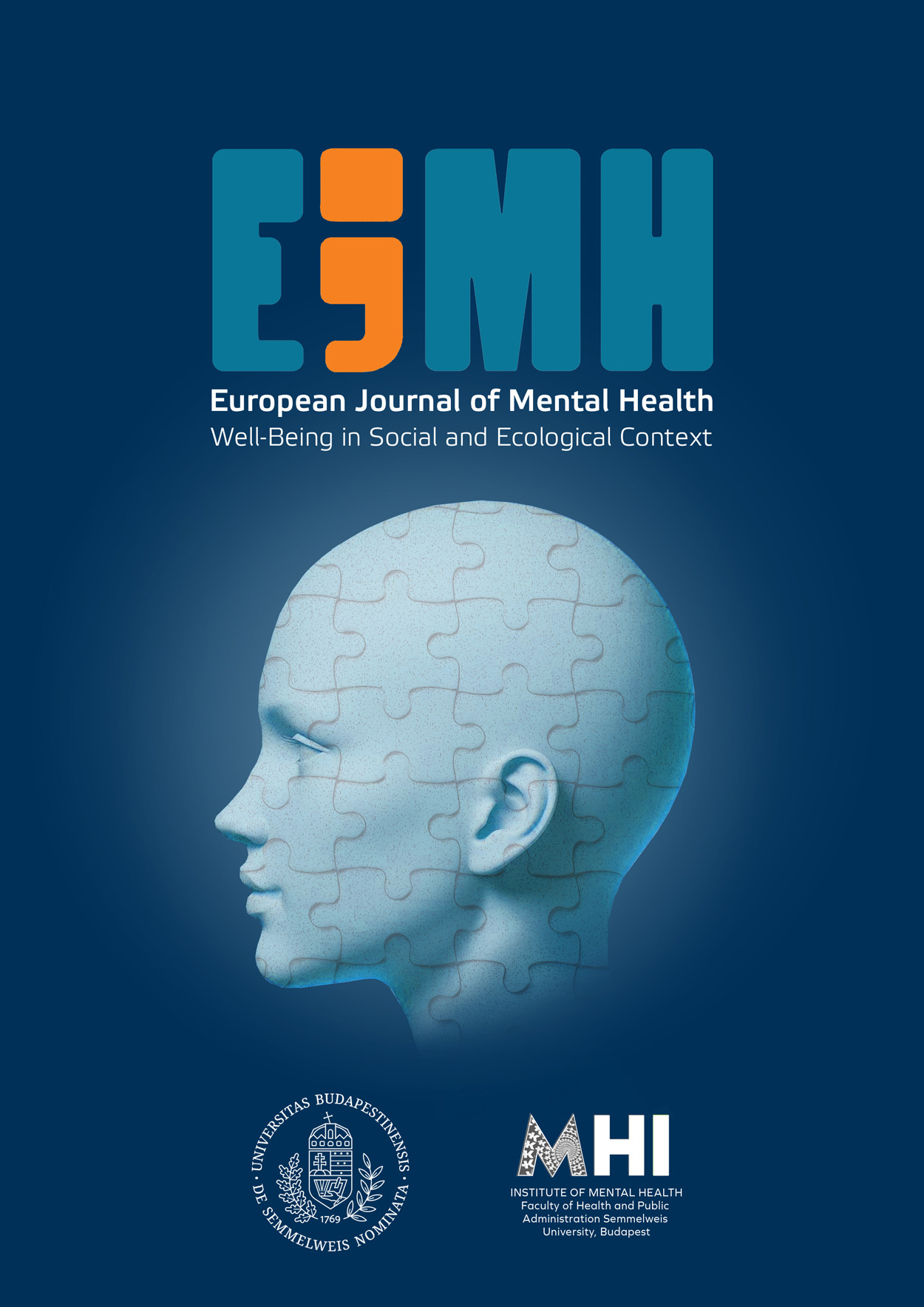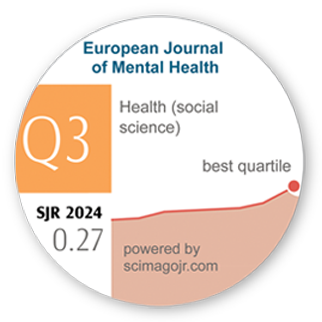Assessing Your Strengths – Hungarian Validation of the 24-Item Values in Action Inventory of Strengths on a Large Sample
DOI:
https://doi.org/10.5708/EJMH.18.2023.0012Keywords:
character strengths, virtues, mental health, positive psychology, positive psychology assessment measureAbstract
Introduction: Several studies have shown the inconsistent factorial structures of the Values in Action Inventory of Strengths between cultures.
Aims: This paper describes an adapted Hungarian version of the 24-item Values in Action Inventory of Strengths for adults.
Methods: Participants in three online self-report questionnaire-based crosssectional studies (Sn = 10,911) filled in the 24-item Values in Action Inventory of Strengths, the Global Well-being Scale, Huppert’s and Diener’s Flourishing Scales, and the Positivity Scale.
Results: The exploratory factor analyses provided evidence for four factors: Wisdom and Knowledge; Humanity; Temperance; and Spirituality and Transcendence. The scales showed excellent internal consistency values in each study. The confirmatory factor analyses of the subsamples also showed a good fit. Low discriminant but excellent content validity was proved. Participants rated themselves highest on Humanity and lowest on Temperance. Women reported significantly higher values on both the Humanity and the Spirituality and Transcendence virtue scales than did men. The Wisdom and Knowledge virtue showed a positive correlation with education level. Among those living alone, Humanity was significantly lower, while the level of Humanity among married people stood significantly higher than in any other group.
Conclusion: Our results suggest that the Hungarian version of the 24-item Values in Action Inventory of Strengths for adults serves as a suitable measure for assessing character strengths and virtues.
References
Ai, A. L., Fincham, F. D., & Carretta, H. (2022). ADL and IADL following open-heart surgery: The role of a character strength factor and preoperative medical comorbidities. Journal of Religion and Health, 61(1), 479–492.
https://doi.org/10.1007/s10943-020-01146-w
Azañedo, C. M., Artola, T., Sastre, S., & Alvarado, J. M. (2021). Character strengths predict subjective well-being, psychological well-being, and psychopathological symptoms, over and above functional social support. Frontiers in Psychology, 12.
https://doi.org/10.3389/fpsyg.2021.661278
Baumann, D., Ruch, W., Margelisch, K., Gander, F., & Wagner, L. (2020). Character strengths and life satisfaction in later life: An analysis of different living conditions. Applied Research in Quality of Life, 15(2), 329–347.
https://doi.org/10.1007/s11482-018-9689-x
Blanchard, T., McGrath, R. E., & Jayawickreme, E. (2021). Resilience in the face of interpersonal loss: The role of character strengths. Applied Psychology: Health and Well‐Being, 13(4), 817–834.
https://doi.org/10.1111/aphw.12273
Blasco-Belled, A., Alsinet, C., Torrelles-Nadal, C., & Ros-Morente, A. (2018). The study of character strengths and life satisfaction: A comparison between affective-component and cognitive-component traits. Anuario de Psicología, 48(3), 75–80.
https://doi.org/10.1016/j.anpsic.2018.10.001
Brdar, I., & Kashdan, T. B. (2010). Character strengths and well-being in Croatia: An empirical investigation of structure and correlates. Journal of Research in Personality, 44(1), 151–154.
https://doi.org/10.1016/j.jrp.2009.12.001
Brdar, I., Anić, P., & Rijavec, M. (2011). Character strengths and well-being: Are there gender differences? In I. Brdar (Ed), The Human Pursuit of Well-Being: A cultural approach (pp. 145–156). Springer.
http://dx.doi.org/10.1007/978-94-007-1375-8_13
Brislin, R. W. (1986). The wording and translation of research instruments. In W. J. Lonner & J. W. Berry (Eds.), Field methods in cross-cultural research (pp. 137–164). Sage Publications.
Caprara, G. V., Alessandri, G., Eisenberg, N., Kupfer, A., Steca, P., Caprara, M. G., Yamaguchi, S., Fukuzawa, A., & Abela, J. (2012). The Positivity Scale. Psychological Assessment, 24(3), 701–712.
https://doi.org/10.1037/a0026681
Cherif, L., Wood, V. M., & Watier, C. (2020). Testing the effectiveness of a strengths-based intervention targeting all 24 strengths: Results from a randomized controlled trial. Psychological Reports, 124(3), 1174–1183.
https://doi.org/10.1177/0033294120937441
Dahlsgaard, K. K. (2005). Is virtue more than its own reward? Character strengths and their relation to well-being in a prospective longitudinal study of middle school-aged adolescents. University of Pennsylvania.
Dahlsgaard, K., Peterson, C., & Seligman, M. E. P. (2005). Shared virtue: The convergence of valued human strengths across culture and history. Review of General Psychology, 9(3), 203–213.
https://doi.org/10.1037/1089-2680.9.3.203
Demirci, I., Ekşi, H., Ekşi, F., & Kaya, Ç. (2021). Character strengths and psychological vulnerability: The mediating role of resilience. Current Psychology, 40(11), 5626–5636.
https://doi.org/10.1007/s12144-019-00533-1
Diener, E., Wirtz, D., Tov, W., Kim-Prieto, C., Choi, D. W., Oishi, S., & Biswas-Diener, R. (2010). New well-being measures: Short scales to assess flourishing and positive and negative feelings. Social Indicators Research, 97(2), 143–156.
https://doi.org/10.1007/s11205-009-9493-y
Duan, W., & Bu, H. (2017). Development and initial validation of a short three-dimensional inventory of character strengths. Quality of Life Research, 26(9), 2519–2531.
https://doi.org/10.1007/s11136-017-1579-4
Fülöp, M. (2008). Education of the cooperative competitive citizen. In K. Tirriri (Ed.), Educating moral sensibilities in urban schools (pp. 171–187). Brill.
Furnham, A., & Lester, D. (2012). The development of a short measure of character strength. European Journal of Psychological Assessment 28(2), 95–101.
https://doi.org/10.1027/1015-5759/a000096
Gander, F., Hofmann, J., Proyer, R. T., & Ruch, W. (2020). Character strengths–Stability, change, and relationships with well-being changes.Applied Research in Quality of Life, 15(2), 349–367.
https://doi.org/10.1007/s11482-018-9690-4
Green, Z. A. (2022). Character strengths intervention for nurturing well‐being among Pakistan’s university students: A mixed‐method study. Applied Psychology: Health and Well‐Being, 14(1), 252–277.
https://doi.org/10.1111/aphw.12301
Harzer, C., & Ruch, W. (2014). The role of character strengths for task performance, job dedication, interpersonal facilitation, and organizational support. Human Performance, 27(3), 183–205.
https://doi.org/10.1080/08959285.2014.913592
Hassaniraad, M., Khodayarifard, M., & Hejazi, E. (2021). Effectiveness of culture-based character strengths training on reinforcing character strengths and promoting students’ mental well-being. Journal of Psychological Science, 19(96), 1533–1545.
Hattori, M., Zhang, G., & Preacher, K. J. (2017). Multiple local solutions and geomin rotation. Multivariate Behavioral Research, 52(6), 720–731.
https://doi.org/10.1080/00273171.2017.1361312
Hausler, M., Strecker, C., Huber, A., Brenner, M., Höge, T., & Höfer, S. (2017). Distinguishing relational aspects of character strengths from subjective and psychological well-being. Frontiers in Psychology, 8, Article 1159.
https://doi.org/10.3389/fpsyg.2017.01159
Heintz, S., & Ruch, W. (2019). Character strengths and job satisfaction: Differential relationships across occupational groups and adulthood. Applied Research in Quality of Life, 15, 503–527.
https://doi.org/10.1007/s11482-018-9691-3
Huppert, F. A. & So, T. T. C. (2013). Flourishing across Europe: Application of a new conceptual framework for defining well-being. Social Indicators Research, 110(3), 837–861.
https://doi.org/10.1007/s11205-011-9966-7
Jacobs, E., Berenbaum, M., & Niemiec, R. M. (2021). Holocaust and humanity: Depicting realities while creating pathways for future upstanders, strengths use, and flourishing. In J. Pawelski & L. Tay (Eds.), The Oxford handbook on the humanities and human flourishing (pp. 178–192). Oxford University Press.
Kopp, M. S., & Réthelyi, J. (2004). Where psychology meets physiology: Chronic stress and premature mortality – The Central-Eastern European health paradox. Brain Research Bulletin, 62(5), 351–367.
https://doi.org/10.1016/j.brainresbull.2003.12.001
Kopp, M., & Skrabski, A. (2009). Why do Hungarian men die early? [Why do Hungarian men die early?]. Neuropsychopharmacologia Hungarica: Official Journal of the Hungarian Association of Psychopharmacology, 11(3), 141–149.
Kor, A., Pirutinsky, S., Mikulincer, M., Shoshani, A., & Miller, L. (2019). A longitudinal study of spirituality, character strengths, subjective well-being, and prosociality in middle school adolescents. Frontiers in Psychology, 10, Article 377.
https://doi.org/10.3389/fpsyg.2019.00377
Lee, M. T., Bialowolski, P., Weziak-Bialowolska, D., Mooney, K. D., Lerner, P. J., McNeely, E., & VanderWeele, T. J. (2021). Self-assessed importance of domains of flourishing: Demographics and correlations with well-being. The Journal of Positive Psychology, 16(1), 137–144.
https://doi.org/10.1080/17439760.2020.1716050
Leontopoulou, S., & Triliva, S. (2012). Explorations of subjective wellbeing and character strengths among a Greek University student sample. International Journal of Wellbeing, 2(3), 251–270.
https://doi.org/10.5502/ijw.v2.i3.6
Linley, P. A., Maltby, J., Wood, A. M., Joseph, S., Harrington, S., Peterson, C., Park, N., & Seligman, M. E. P. (2007). Character strengths in the United Kingdom: The VIA inventory of strengths. Personality and Individual Differences, 43(2), 341–351.
https://doi.org/10.1016/j.paid.2006.12.004
Lounsbury, J. W., Fisher, L. A., Levy, J. J., & Welsh, D. P. (2009). An investigation of character strengths in relation to the academic success of college students. Individual Differences Research, 7(1), 52–69.
Macdonald, C., Bore, M., & Munro, D. (2008). Values in action scale and the Big 5: An empirical indication of structure. Journal of Research in Personality, 42(4), 787–799.
https://doi.org/10.1016/j.jrp.2007.10.003
Martínez-Martí, M. L., & Ruch, W. (2017). Character strengths predict resilience over and above positive affect, self-efficacy, optimism, social support, self-esteem, and life satisfaction. The Journal of Positive Psychology, 12(2), 110–119
https://doi.org/10.1080/17439760.2016.1163403
McGrath, R. E. (2015). Integrating psychological and cultural perspectives on virtue: The hierarchical structure of character strengths. The Journal of Positive Psychology, 10(5), 407–424.
https://doi.org/10.1080/17439760.2014.994222
McGrath, R. E. (2019). The VIA assessment suite for adults: Development and initial evaluation revised edition. VIA Institute on Character.
McGrath, R. E., & Walker, D. I. (2016). Factor structure of character strengths in youth: Consistency across ages and measures. Journal of Moral Education, 45(4), 400–418.
https://doi.org/10.1080/03057240.2016.1213709
Muthén, L. K., & Muthén, B. O. (1998–2011). Mplus User’s Guide (6th ed.). Muthén & Muthén.
Neto, J., Neto, F., & Furnham, A. (2014). Gender and psychological correlates of self-rated strengths among youth. Social Indicators Research, 118(1), 315–327.
https://doi.org/10.1007/s11205-013-0417-5
Ng, V., Cao, M., Marsh, H. W., Tay, L., & Seligman, M. E. (2017). The factor structure of the Values in Action Inventory of Strengths (VIA-IS): An item-level exploratory structural equation modeling (ESEM) bifactor analysis. Psychological Assessment, 29(8), 1053–1058.
https://doi.org/10.1037/pas0000396
Oláh, A. (2016). A new model and a new inventory of well-being. In Complete abstract book –per theme – per type of session of the 8th European Conference on Positive Psychology (pp. 55).
Oláh, A. (2019). Positivity is an up-to-date predictor of well-functioning instead of a eudaemon. Asian Journal of Social Psychology 22(2), 143–145.
https://doi.org/10.1111/ajsp.12362
Park, N., & Peterson, C. (2006). Moral competence and character strengths among adolescents: The development and validation of the Values in Action Inventory of Strengths for Youth. Journal of Adolescence, 29(6), 891–909.
https://doi.org/10.1016/j.adolescence.2006.04.011
Peterson, C., & Seligman, M. E. (2004). Character strengths and virtues: A handbook and classification (Vol. 1). Oxford University Press.
Peterson, C., Park, N., Pole, N., D’Andrea, W., & Seligman, M. E. (2008). Strengths of character and posttraumatic growth. Journal of Traumatic Stress, 21(2), 214–217.
https://doi.org/10.1002/jts.20332
Piko, B. . (2004). Interplay between self and community: A role for health psychology in Eastern Europe’s public health. Journal of Health Psychology, 9(1), 111–120.
https://doi.org/10.1177/1359105304036105
Ruch, W., Gander, F., Wagner, L., & Giuliani, F. (2021). The structure of character: On the relationships between character strengths and virtues. The Journal of Positive Psychology, 16(1), 116–128.
https://doi.org/10.1080/17439760.2019.1689418
Ruch, W., & Proyer, R. T. (2015). Mapping strengths into virtues: The relation of the 24 VIA-strengths to six ubiquitous virtues. Frontiers in Psychology, 6, Article 460.
https://doi.org/10.3389/fpsyg.2015.00460
Ruch, W., Proyer, R. T., Harzer, C., Park, N., Peterson, C., & Seligman, M. E. (2010). Values in action inventory of strengths (VIA-IS): Adaptation and validation of the German version and the development of a peer-rating form. Journal of Individual Differences, 31(3), 138–149.
https://doi.org/10.1027/1614-0001/a000022
Sallay, H., & Krotos, H. (2004). ). Az igazságos világba vetett hit fejlődése: japán-magyar kultúraközi összehasonlítás. [The development of just world beliefs: A cross-cultural comparison between Japan and Hungary]. Pszichológia, 24(3), 233–253.
Schutte, N. S., & Malouff, J. M. (2019). The impact of signature character strengths interventions: A meta-analysis. Journal of Happiness Studies, 20(4), 1179–1196.
https://doi.org/10.1007/s10902-018-9990-2
Seligman, M. E. P. (2002). Authentic happiness: Using the new positive psychology to realize your potential for lasting fulfillment. Free Press.
Seligman, M. E. P. (2011). Flourish: A visionary new understanding of happiness and well-being. Simon and Schuster.
Seligman, M., & Csikszentmihalyi, M. (2000). Positive psychology: An introduction. American Psychologist, 55(1), 5–14.
https://doi.org/10.1037//0003-066X.55.1.5
Shoshani, A., & Slone, M. (2016). The resilience function of character strengths in the face of war and protracted conflict. Frontiers in Psychology, 6, Article 2006.
https://doi.org/10.3389/fpsyg.2015.02006
Shryack, J., Steger, M. F., Krueger, R. F., & Kallie, C. S. (2010). The structure of virtue: An empirical investigation of the dimensionality of the Virtues in Action Inventory of Strengths. Personality and Individual Differences, 48(6), 71
https://doi.org/10.1016/j.paid.2010.01.007
Singh, K., & Choubisa, R. (2010). Empirical validation of Values in Action–Inventory of Strengths (VIA-IS) in Indian context. Psychological Studies, 55(2), 151–158.
https://doi.org/10.1007/s12646-010-0015-4
Szabó, C., Pukánszky, J., & Kemény, L. (2020). Psychological effects of the COVID-19 pandemic on Hungarian adults. International Journal of Environmental Research and Public Health, 17(24), Article 9565.
https://doi.org/10.3390/ijerph17249565
Vargha, A. (2016). A ROPstat statisztikai programcsomag [ROPstat Statistical Package]. Statisztikai Szemle, 94(11–12), 1165–1192.
https://doi.org/10.20311/stat2016.11-12.hu1165
Wagner, L., Gander, F., Proyer, R. T., & Ruch, W. (2020). Character strengths and PERMA: Investigating the relationships of character strengths with a multidimensional framework of well-being. Applied Research in Quality of Life, 15(2), 307–328.
https://doi.org/10.1007/s11482-018-9695-z
Wagner, L., Pindeus, L., & Ruch, W. (2021). Character strengths in the life domains of work, education, leisure, and relationships and their associations with flourishing. Frontiers in Psychology, 12, Article 597534.
https://doi.org/10.3389/fpsyg.2021.597534
Wagner, L., & Ruch, W. (2015). Good character at school: Positive classroom behavior mediates the link between character strengths and school achievement. Frontiers in Psychology, 6, Article 610.
https://doi.org/10.3389/fpsyg.2015.00610
Weziak-Bialowolska, D., Bialowolski, P., VanderWeele, T. J., & McNeely, E. (2021). Character strengths involving an orientation to promote good can help your health and well-being. Evidence from two longitudinal studies. American Journal of Health Promotion, 35(3), 388–398.
https://doi.org/10.1177/0890117120964083






